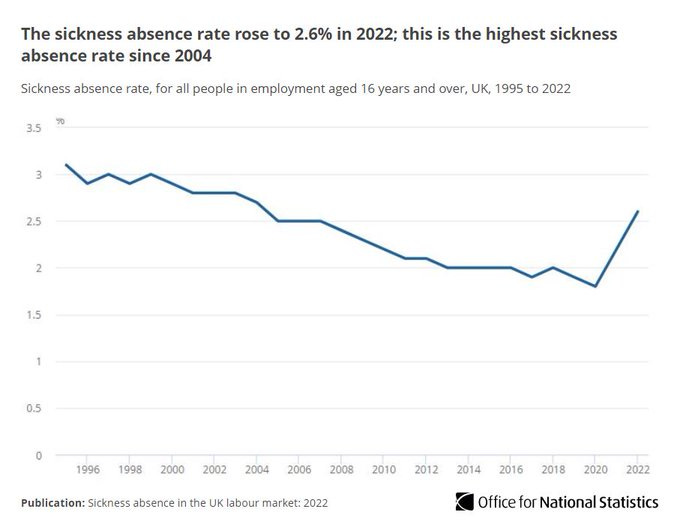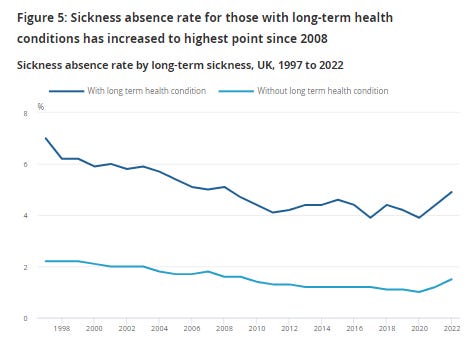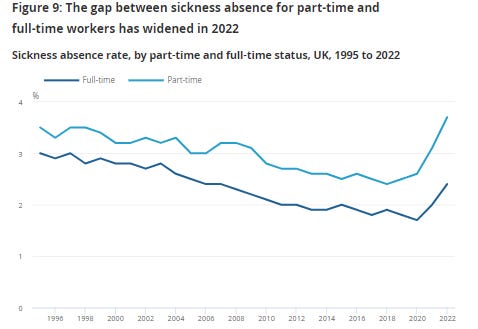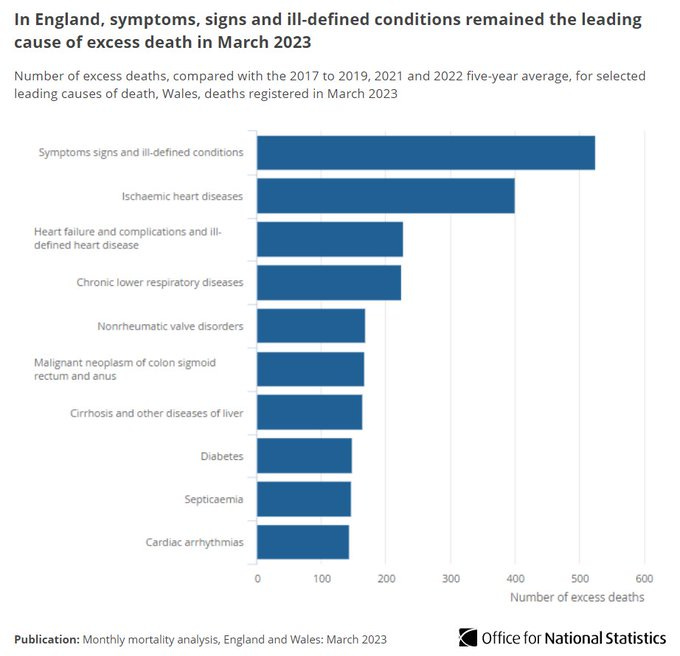The long term sickness absence rate in the UK has been on a steady downward trend since at least the mid 90s. Even in 2020, when we had to lockdown due to a deadly circulating virus, the trend continued downwards.
But according to the Office for National Statistics’ (ONS) latest publication - ‘Sickness absence in the UK labour market: 2022’ - something happened in 2021 to reverse this trend. And sharply.
The sickness absence rate in 2020 was 1.8% but rose 44% to 2.6% in 2022. Within two years almost 20 years of progress has been wiped out with absence rates similar to those in 2004.
This isn’t a trivial issue either because it also impacts the economy, as well as the health of the people involved. An estimated 185.6 million working days were lost in 2022, a new record high. This represents a 57% increase from the 118 million working days lost in 2022.
What were the reasons for sickness? Looking at the graph below shows that musculoskeletal problems and mental health conditions (with a slight rise in 2020) have been trending downwards since 2019. Respiratory conditions have been steadily rising since 2019 but interestingly there was no spike in 2020. ‘Other’ has dropped down since 2021 but the category with the biggest change of direction is minor illness. Steadily dropping until 2021, it suddenly surged up again in 2022.
Another interesting point to note is that the biggest increase has been in healthy people. There is a 26% rise in absence rates in people with long term health conditions but a 50% increase in those without any long term health conditions.
Also surprising is that, whilst rates are higher for public sector employees, the rate of change since 2020 is higher in the private sector with a 44% increase (compared with a 33% rise in the public sector).
Looking at full-time workers versus part-time workers reveals very little difference with massive rises in both. Full time worker absence rose 41% since 2020 and part time 42%.
What is causing this big spike in sickness? Possible reasons include:
Increased stress and pandemic related mental illness. This can likely be discounted as absence due to mental health conditions has actually fallen. There is still the possibility that stress is making people ill.
Lack of job satisfaction. Working from home has made people less engaged with their jobs and are looking for something different.
Working from home has allowed more people to pretend they are ill to get a long weekend etc. But why would this continue to rise in 2022 when people stopped working from home as much?
Covid and Long Covid. But why did absence rates drop in 2020?
Adverse events from vaccines and the immunosuppressant effect allowing other illnesses to take hold.
Many people will only consider the vaccine injury answer as being correct but all theories should be looked at. Are there any other reasons you can think of for absences due to sickness increasing since 2020?
And is there a link between these minor illnesses causing people to take time off from work and excess deaths. There were at least 5,679 excess deaths (12.6%) above the March five-year average in England with the leading cause of death being ‘symptoms signs and ill-defined conditions).










Another thought: here in the States, the government cretins actually paid people not to work, probably in a lot of cases better than what they made slogging 40 hours a week. That has created a seismic shift in a formerly hard working ethic here. And tons of people have never gone back to work, or insist on working from home, etc. When you’re not engaged in your job & co-workers, it’s easier to claim you’re sick when you’re just flat out used to doing what you want at home w/ little-to-no oversight.
All of that said, if the jabs aren’t killing everyone or causing immediate damage, they’re slowly decimating immune systems, & more w/ every jab. We never knew what the “long term” effects of the poisons would be, but we’re finding out now & in decades to come
As much as I’d love to blame the injections, I think you also have to factor in that it remains less socially acceptable to go to work with symptomatic illness than it was previously.
Also, three years of elevated infection consciousness has had a psychological impact too I think. People seem to more readily allow themselves to relent to being ill and to rest; as opposed to piling in the Lemsip Max, driving through the adrenaline and getting themselves on their feet.
I make no comment as to whether that is right or wrong (I don’t know) but I think it might impact the stats.